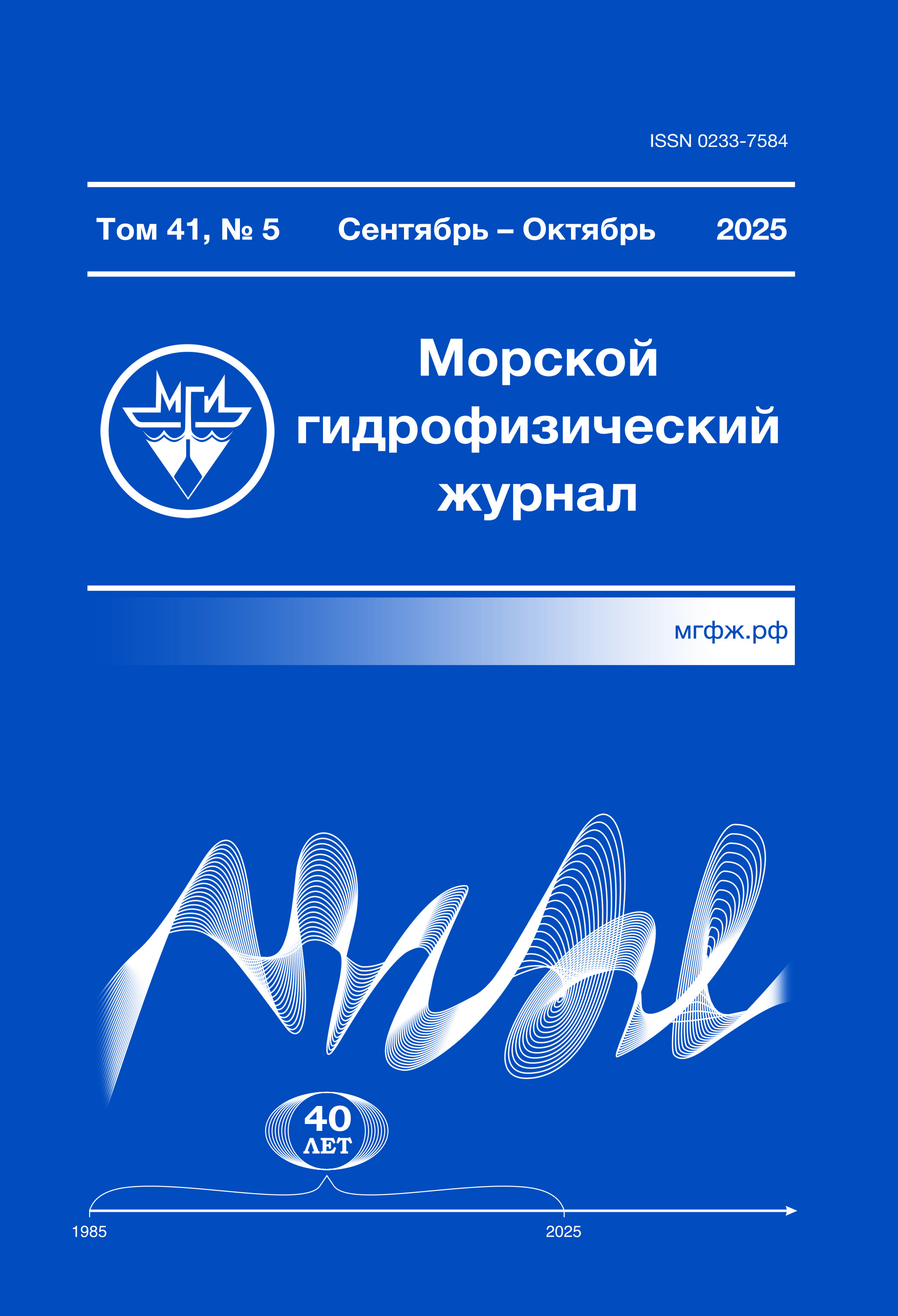Russian Federation
Russian Federation
Purpose. The purpose of the work is to study the possibility of improving spatial resolution of the Ad-vanced Microwave Scanning Radiometer 2 (AMSR2) on the C-band channels using the measurements at the 36.5 GHz frequency for investigating the underlying surface parameters of the Arctic seas. Methods and Results. The results of numerical modeling of the brightness temperature (T) of the sea ice-ocean-atmosphere system microwave radiation under conditions of the non-scattering Arctic atmos-phere, as well as the calculations of T for the atmospheric and oceanic parameters based on the ERA5 reanalysis data were used. The values of sea ice effective emission coefficients previously calculated for the entire Arctic region were applied in calculations. The T sensitivity to atmospheric radiation, surface temperature and underlying surface emission coefficients at the 6.9 and 36.5 GHz measurement chan-nels at the horizontal and vertical polarizations, and also variability of the above parameters in the Arctic were assessed. Depending on the surface type and based on the modeling results, proposed are the for-mulas for calculating the T fields at the 6.9 GHz frequency at the enhanced spatial resolution, in which T at the 6.9 GHz frequency of the original resolution and T at the 36.5 GHz frequency of the Level 1R satellite product were used. Conclusions. The developed approach expands the possibilities of using the AMSR2 data for a detailed study of the parameters of Arctic seas partially or completely covered with first-year ice of various types and concentration. For the areas of continuous multi-year consolidate ice, application of the described method to improving the spatial resolution of measurements at 6.9 GHz, especially in vertical polariza-tion, seems impossible. The errors and applicability of the above approach are conditioned by the varia-bility of atmospheric water content parameters in a low spatial resolution pixel of measurements at the 6.9 GHz frequency.
AMSR2, brightness temperature, spatial resolution, Arctic, sea ice-ocean-atmosphere system, physical modeling, sea ice
1. Zabolotskih E. V., Shapron B. Vosstanovlenie integral'noy vlazhnosti atmosfery nad okeanami po dannym sputnikovogo mikrovolnovogo radiometra AMSR2 // Sovremennye problemy distancionnogo zondirovaniya Zemli iz kosmosa. 2017. T. 14, № 1. C. 207–215. EDN YRBYKD. https://doi.org/10.21046/2070-7401-2017-14-1-207-215
2. A physical retrieval of cloud liquid water over the global oceans using special sensor micro-wave/imager (SSM/I) observations / T. J. Greenwald [et al.] // Journal of Geophysical Re-search: Atmospheres. 1993. Vol. 98, iss. D10. P. 18471–18488. https://doi.org/10.1029/93JD00339
3. Satellite measurements of sea surface temperature through clouds / F. J. Wentz [et al.] // Sci-ence. 2000. Vol. 288, iss. 5467. P. 847–850. https://doi.org/10.1126/science.288.5467.847
4. Comiso J. C. Enhanced sea ice concentrations and ice extents from AMSR-E data // Journal of The Remote Sensing Society of Japan. 2009. Vol. 29, iss. 1. P. 199–215. https://doi.org/10.11440/rssj.29.199
5. Estimation of snow depth from AMSR2 and MODIS data based on deep residual learning network / D. Xing [et al.] // Remote Sensing. 2022. Vol. 14, iss. 20. 5089. https://doi.org/10.3390/rs14205089
6. Lu M., Hoang K. O., Kumarasiri A. D. T. N. Temperature effects in AMSR2 soil moisture products and development of a removal method using data at ascending and descending over-passes // Remote Sensing. 2024. Vol. 16, iss. 9. 1606. https://doi.org/10.3390/rs16091606
7. On the spatial resolution enhancement of microwave radiometer data in Banach spaces / F. Lenti [et al.] // IEEE Transactions on Geoscience and Remote Sensing. 2013. Vol. 52, iss. 3. P. 1834–1842. https://doi.org/10.1109/TGRS.2013.2255614
8. Long D. G., Brodzik M. J., Hardman M. A. Enhanced-resolution SMAP brightness tempera-ture image products // IEEE Transactions on Geoscience and Remote Sensing. 2019. Vol. 57, iss. 7. P. 4151–4163. https://doi.org/10.1109/TGRS.2018.2889427
9. Sethmann R., Burns B. A., Heygster G. C. Spatial resolution improvement of SSM/I data with image restoration techniques // IEEE transactions on Geoscience and Remote Sensing. 1994. Vol. 32, iss. 6. P. 1144–1151. https://doi.org/10.1109/36.338362
10. Status of AMSR2 instrument on GCOM-W1 / K. Imaoka [et al.] // Proceedings of SPIE. SPIE, 2012. Vol. 8528 : Earth Observing Missions and Sensors: Development, Implementation, and Characterization II. 852815. https://doi.org/10.1117/12.977774
11. The development of an algorithm to enhance and match the resolution of satellite measurements from AMSR-E / Y. Wang [et al.] // Science China Earth Sciences. 2011. Vol. 54, iss. 3. P. 410–419. https://doi.org/10.1007/s11430-010-4074-0
12. Validation of hi-resolution sea surface temperature algorithm toward the satellite-borne micro-wave radiometer AMSR3 Mission / T. Maeda [et al.] // IEEE Geoscience and Remote Sensing Letters. 2021. Vol. 19. 4500305. P. 1–5. https://doi.org/10.1109/LGRS.2021.3066534
13. An enhanced resolution brightness temperature product for future conical scanning microwave radiometers / F. Nunziata [et al.] // IEEE Transactions on Geoscience and Remote Sensing. 2021. Vol. 60. 5301812. P. 1–12. https://doi.org/10.1109/TGRS.2021.3109376
14. Choi M., Hur Y. A microwave-optical/infrared disaggregation for improving spatial representa-tion of soil moisture using AMSR-E and MODIS products // Remote Sensing of Environment. 2012. Vol. 124. P. 259–269. https://doi.org/10.1016/j.rse.2012.05.009
15. Santi E. An application of the SFIM technique to enhance the spatial resolution of spaceborne microwave radiometers // International Journal of Remote Sensing. 2010. Vol. 31, iss. 9. P. 2419–2428. https://doi.org/10.1080/01431160903005725
16. Long D. G., Hardin P. J., Whiting P. T. Resolution enhancement of spaceborne scatterometer data // IEEE Transactions on Geoscience and Remote Sensing. 1993. Vol. 31, iss. 3. P. 700–715. https://doi.org/10.1109/36.225536
17. Spatial resolution and data integrity enhancement of microwave radiometer measurements using total variation deconvolution and bilateral fusion technique / W. Hu [et al.] // Remote Sensing. 2022. Vol. 14, iss. 14. 3502. https://doi.org/10.3390/rs14143502
18. Spatial resolution matching of microwave radiometer data with convolutional neural network / Y. Li [et al.] // Remote Sensing. 2019. Vol. 11, iss. 20. 2432. https://doi.org/10.3390/rs11202432
19. Liu J. G. Smoothing filter-based intensity modulation: A spectral preserve image fusion tech-nique for improving spatial details // International Journal of Remote Sensing. 2000. Vol. 21, iss. 18. P. 3461–3472. https://doi.org/10.1080/014311600750037499
20. A simple technique to improve the AMSR-E spatial resolution at C-band / E. Santi [et al.] // 2008 Microwave Radiometry and Remote Sensing of the Environment. Florence, Italy, 2008. P. 1–4. https://doi.org/10.1109/MICRAD.2008.4579458
21. Meissner T., Wentz F. J. The emissivity of the ocean surface between 6 and 90 GHz over a large range of wind speeds and earth incidence angles // IEEE Transactions on Geoscience and Remote Sensing. 2012. Vol. 50, iss. 8. P. 3004–3026. https://doi.org/10.1109/TGRS.2011.2179662
22. Matrosov S. Yu., Shul'gina E. M. Rasseyanie i oslablenie mikrovolnovogo izlucheniya osadkami // Trudy Glavnoy geofizicheskoy observatorii im. A. I. Voeykova. 1981. T. 448. P. 85–94.
23. Svendsen E., Matzler C., Grenfell T. C. A model for retrieving total sea ice concentration from a spaceborne dual-polarized passive microwave instrument operating near 90 GHz // International Journal of Remote Sensing. 1987. Vol. 8, iss. 10. P. 1479–1487. https://doi.org/10.1080/01431168708954790
24. Zabolotskikh E. V., Chapron B. Estimation of atmospheric microwave radiation parameters over the Arctic Sea ice from the AMSR2 Data // IEEE Transactions on Geoscience and Remote Sensing. 2024. Vol. 62. 4104211. P. 1–11. https://doi.org/10.1109/TGRS.2024.3392369
25. Ulaby F. T., Moore R. K., Fung A. K. Microwave remote sensing: Active and passive. Volume 1. Microwave remote sensing fundamentals and radiometry. Reading, MA : Addison-Wesley Publishing Co., 1981. 456 p.
26. Zabolotskikh E., Azarov S. Wintertime emissivities of the Arctic Sea ice types at the AMSR2 frequencies // Remote Sensing. 2022. Vol. 14, iss. 23. 5927. https://doi.org/10.3390/rs14235927
27. Zabolotskih E. V., Balashova E. A., Shapron B. Usovershenstvovannyy metod vosstanov-leniya splochennosti morskogo l'da po dannym sputnikovyh mikrovolnovyh izmereniy vblizi 90 GGc // Sovremennye problemy distancionnogo zondirovaniya Zemli iz kosmo-sa. 2019. T. 16, № 4. P. 233–243. EDN JVEHCG. https://doi.org/10.21046/2070-7401-2019-16-4-233-243
28. Klassifikaciya morskogo l'da v Arktike po dannym AMSR2 / E. V. Zabolotskih [i dr.] / Sovremennye problemy distancionnogo zondirovaniya Zemli iz kosmosa. 2024. T. 21, № 5. P. 263–27. EDN JLANJU. https://doi.org/10.21046/2070-7401-2024-21-5-263-274


















